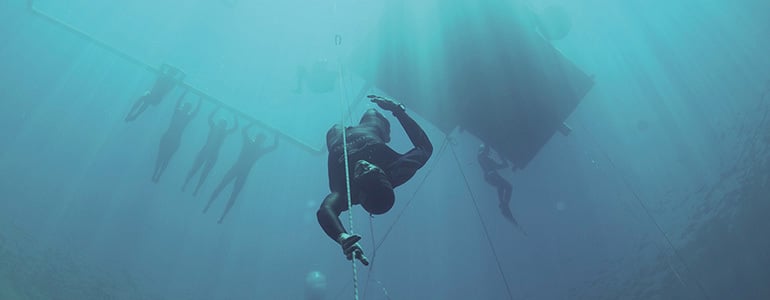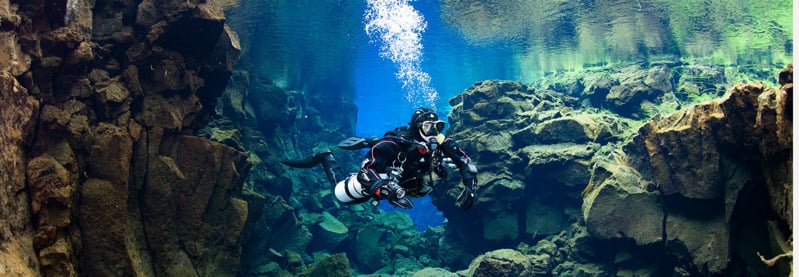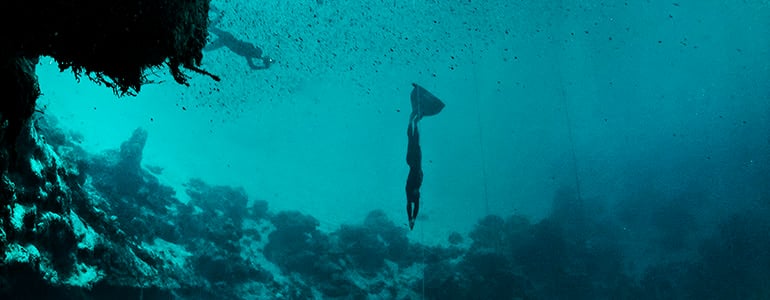

SUUNTOブログ

One with the ocean
“The appeal of freediving is how different it is to any other sport. The fact we’re completely immersed in liquid; a single breath, the weightlessness, the absence of sounds, the dullness of the colors... everything is subtracted,” says freediver William Trubridge.
"It’s a completely different experience to life in the air element. When I'm diving it feels like I'm being accepted into the ocean."
Trubridge, 35, is a multiple record-breaking freediver who has a natural affinity with the depths of the ocean. He is the first person to dive to 100 m without assistance.
The ocean and its depths are as much William Trubridge’s home as his life on land.
Born in Britain, the first few years of his life were a nomadic existence sailing around the world on his parents' yacht before the family settled in New Zealand. He learnt to swim at the age of 18 months, and was freediving to 15 m by the age of eight, competing with his older brother to see who could bring back a stone from the deepest depth. But it was not until he was 22 that he discovered freediving was a sport. Since then, Trubridge has broken numerous freediving records, including in 2010 becoming the first person to break the hectometer; diving to 100 m without assistance.
His immersion in the aquatic world has made protecting the ocean a lifelong passion for Trubridge. In 2015, he launched the Plastic Challenge, a global campaign to raise awareness about the problem of seaborne plastic pollution. The campaign motivated people all over the world to clean up their local beaches and waterways. Trubridge is also a vocal ambassador of a NABU International campaign to save the critically endangered Maui and Hector dolphins.
For much of the year he is based in the Bahamas, where he trains at Dean's Blue Hole, It is also the location of Suunto Vertical Blue, one of the largest freediving events in the world, which Trubridge organizes.
Although considered the world's best 'no-fins' freediver, Trubridge is also a multiple record holder in 'Free Immersion', where divers descend pulling on a rope. In 2011 and 2012 he received the World's Absolute Freediving Award (WAFA), which ranked him as the world's top freediver.
RECORDS:
Constant Weight No Fins (CNF): 101m Free Immersion (FIM): 121mCheck more at www.aidainternational.org/competitive/worlds-records
Watch Face to Face with Will Trubridge, #SuuntoAdventure Video Series Episode 4

Dogsledding and diving in Greenland
It was a unique coming together of western explorers, locals and traditional hunter-fishermen. Four members of the Under the Pole expedition team, five young Inuit from the Uummannaq Children’s Home and two accompanying teachers were guided by Inuit hunter-fishermen on a 600 km dogsled adventure beyond Greenland's northern most territories.
First ice camp. © Lucas Santucci/Under the Pole
They learned how to manage a dogsled pack, how to go fishing on the ice to catch a feed for the pack, how to create a warm tent with reindeer skins and even a Greenlandic card game or two. The team, in return, guided the Inuit on their first ever dives beneath the ice.
Ghislain Bardout guiding teenager Nukaaraq under a glass ceiling. © Lucas Santucci/Under the Pole
Poor weather and a lack of snow this winter, however, nearly scuttled this last stage of the expedition. Exposed surface ice is abrasive to the dogs’ legs. Too little snow also means a lack of an easy water source. Fortunately conditions improved and the party set off north into the magical landscape between mountains and ocean.
They traveled by dogsled for eight days, sleeping in hunting cabins or in tents on the ice, learning about traditional Inuit ways.
12-year-old Miannguac sitting by a fishing hole to catch dinner for the dogs. © Lucas Santucci/Under the Pole
Whenever possible, the team encouraged the hunters and young people to dive.
“I was really impressed by their ability to adapt to the situation,” says Ghislain Bardout. “The way they moved under the sea ice despite the fact some of them can barely swim.
“After several dives, the most adventurous moved 10 m away from the hole and enjoyed observing the sea bed, fish and ice ceiling.
“Our objective was achieved; the young people became explorers of their own environment.”
All the young sub ice explorers and divers received certificates. © Lucas Santucci/Under the Pole
Main photo: © Lucas Santucci/Under the Pole

Top performances at Suunto Vertical Blue 2015
The big news from Suunto Vertical Blue 2015 isn’t who became overall winner.
With multiple record holder Will Trubridge’s main rival Russian Alex Molchanov out of this year’s competition, Will won the top spot unchallenged.
But that doesn’t mean he didn’t learn a thing or two. On day three he had a run in with the dazed and confused, absent-minded state that sometimes bewilders freedivers when they’re in the depths.
Will Trubridge took home gold. ©Daan Verhoeven
Once they’ve hit maximum depth and to prove they’ve reached it, freedivers must collect a tag from the bottom plate at the end of a line that hangs from the surface. Sounds simple enough, right?
Wrong. After diving down vertically for minutes on a single breath the body is desperate for oxygen, sometimes resulting in what’s called nitrogen narcosis which can cause confusion, even hallucinations.
It's not uncommon for freedivers to experience hallucinations. ©Daan Verhoeven
Freedivers have to rely on their training and on visualization techniques to stay calm and to swim to the surface, one patient stroke at a time.
“I had some difficulty at the bottom plate attaching the tag to the velcro on my leg and ended up stuffing it in the neck of my wetsuit instead,” Will says. “I must have been pretty narced (experiencing nitrogen narcosis), which increased on the way up — meaning I didn’t find the complete relaxation I was looking for.
“It was still a clean dive, and fairly quick for that FIM depth.”
Will Trubridge is competing in two more competitons in the next two months. ©zooom.at/ Samo Vidic
The next day, however, Will returned to perfect form and achieved a constant weight dive to 116 m in 3 m 17 s.
“I'm happy with how I performed, finishing with maximum depths of 94m CNF, 115m FIM and 116/120 m CWT.”
Sayuri Kinoshita from Japan was the overall winner of the women. She broke Japan’s national FIM record four times and the CNF national record once.
The bigger splash to come out of this year’s event is that 29 national records were broken by 12 of the 23 freedivers taking part. Colombian Sofia Gómez Uribe earned national records in the event’s three sports; FIM, CNF, CWT. Five other athletes broke national records in two sports.
Tomoka Fukada broke Japan's national FIM record. ©Daan Verhoeven
For the men, Ryuzo Shinomiya of Japan came in second, followed by Alejandro Lemus of Mexico. For the women, Tomoka Fukada from Japan came second and Katerina Linczenyovia of Slovakia came third.
“Above all, this year’s contest has been a lot of fun,” Will Trubridge says. “We've had some spectacular conditions in the Blue Hole as well as rain, wind and cold and I've been able to perform in both, so that’s good to take away from this event and into the next two competitions in Honduras (Caribbean Cup) and Colombia (Nirvana).”
Another great year for Suunto Vertical Blue at Deans Blue Hole in the Bahamas. ©zooom.at/ Samo Vidic
Main photo: ©Daan Verhoeven

Heinerth publishes children's book
He's a manatee named Chester and he's not in great shape. Meet the star of Jill Heinerth's new children's book. Just published, Chester the Manatee and the Very, Very, Terribly Bad Itch is part of Jill's quest to educate children about the state of our water. Below she tells us about the new book, and why she feels manatees have much to teach us.
So what's the idea behind the book? Chester the Manatee and the Very, Very, Terribly Bad Itch is a book that follows the life of a gentle manatee facing struggles from a very annoying itch. He reaches out to a young girl who helps him discover the cause of his problem. The little girl helps Chester by teaching people about keeping water clean. Chester the Manatee supports children who feel different, embrace their special characteristics. The book celebrates unique kids as remarkable people who help teach others about important issues.
You're quite a fan of manatees right? The book is a part of my efforts to educate people about their water issues. Recently some misguided but well-meaning people started to lobby to end activities that allow people to swim with manatees. Anyone who has had the privilege to swim with manatees is transformed by the experience and there is no evidence to support that any of the wild manatees are harmed. They have special refuge areas to escape and yet they leave the refuges to interact with humanity. I truly believe the manatees are trying to teach us something. None have been harmed by human interaction in the water and yet many die of cold stress each year. Their habitat has been destroyed by our use of herbicides, pesticides and fertilizers on the golf course style lawns we keep in Florida. The bottom vegetation is now gone and replaced by filamentous algae that does not have the nutritional value they require. They have to leave the warmth of the springs to swim out to the Gulf of Mexico to feed. Some don’t make the return trip in time to beat cold weather and henceforth die of cold stress.
I realize that it is critical to help everyone understand that humans’ swimming with manatees are the best chance we have to protect the water they are swimming in. People have to learn from the operators in the area about how to change their behaviors to protect water resources. I hope this book will help.What’s the story about? Beyond the environmental message of protecting water, I want to empower kids. Sometimes we all feel like we are different or that nobody understands us. I am trying to encourage kids to be confident and understand that they can help change the world.What else are you up to right now? I have a busy summer ahead with work in Greece, the Azores, Newfoundland and England. I’ll be doing some filming of caves, wildlife, wrecks, icebergs and a newly opened flooded mine. I’m also looking forward to going back to Cuba soon. I am working with National Geographic on a project that involves an international team of scientists and explorers. We’re looking at early human remains and unique paleontology as well as getting a better understanding of global climate change.
You can order the book on iTunes here.
Top freedivers descend for Suunto Vertical Blue 2015
One breath, a hundred meters into the depths and back again.
That’s the kind of incredible mental and physical mastery you can expect to see between April 27 and May 07 at Suunto Vertical Blue 2015, a free diving competition held in the world's deepest blue hole.
Dean's Blue Hole is 202 m deep. ©zooom.at/ Agustin Munoz
Suunto Vertical Blue is one of the world’s top freediving events where competitors aim to push the boundaries of human aquatic potential, diving vertically for minutes on one breath.
The first of 23 divers from 12 countries take the plunge on April 27, day one of the nine-day competition. They’ll be competing in three disciplines (see below), with some aiming to break world and national records or personal bests.
Japanese freediver Tomoka Fukada is competing again at this year's event. ©Daan Verhoeven
To deepen your understanding on freediving, jump into this article.
Located on Long Island in the Bahamas, the mysterious Dean’s Blue Hole is a postcard perfect tropical cove from above. But past the sandy shores it drops off abruptly, falling 202 m before hitting the sea floor below.
The depth, warmth and clarity of its waters make Dean’s Blue Hole to free diving what Maui is to surfing. It’s a magnet for the best, including multiple record holder William Trubridge who founded the Vertical Blue competition back in 2006.
Event organizer Will Trubridge holds world records for freediving. ©zooom.at/ Samo Vidic
Will Trubridge has won the overall title five years straight and aims to continue his streak. With his main rival Alexey Molchanov not competing this year, there will be less standing in his way.
But with back-to-back competitions in the next few months and world championships in September, Will isn’t promising to break any records this time around.
“I'm just looking to build depth and confidence in this phase of the year,” he says. “If I’m at a level where I feel comfortable going for a world record in one of the disciplines then I will definitely do that.”
Dean's Blue Hole's warm, clear waters attracts the best freedivers. ©zooom.at/ Samo Vidic
For the first time in four years, the event is being held in April to take advantage of favorable spring weather conditions.
“It’s been a while since we’ve competed in Dean’s Blue Hole during spring, when weather and water clarity tend to be better, so I’m looking forward to that,” Will says.
Stay tuned for more updates on Suunto Vertical Blue 2015.
Three disciplines:
Constant weight (CWT): descending and ascending using fins and arms only.
Free immersion (FIM): descending and ascending by pulling on the rope.
Constant no-fins (CNF): considered the purist freediving discipline – descending and ascending without fins or other artificial means.

A visual guide to freediving
There are some adventure sports that have only been around for a matter of years, sports like ice-climbing, kiteboarding. Then there are others that have existed for only hundreds of years, like skiing and running. But there's one sport that has been around since the dawn of time itself – freediving.
Humans have been holding their breath and diving in water for thousands of years – to fish, and more recently, to have fun and compete. In fact, humans are so uniquely adapted to going underwater it's possible to argue that we've freediving before we even became human.
What happens during a dive? Check the infographic below:
Graphic: ©zooom.at/Adi Sumic
What are those special attributes that we share with other aquatic beings that make freediving possible? It all comes down to the so-called 'dive reflex'. The main feature of this is the slowing of the heart which automatically occurs once the face is submerged in water. This has the effect of reducing oxygen consumption so you can hold your breath for longer.
The dive reflex kicks in again after approximately 25 m: the heart rate slows by as much as 50% and vasoconstriction takes place. This is where warm blood retreats from the body's extremities to protect core organs. Again, this has the effect of lengthening the time we can spend underwater.
Will Trubridge competing at the 2014 Suunto Vertical Blue ©Daan Verhoeven
At this depth most divers can stop swimming – and just freefall to the depths below. It is this part of the dive that can induce the most pleasant feelings. Many freedivers feel euphoric as they enter an almost trance-like state.
Descent can be as fast as a meter a second so a world class freediver can expect to reach a depth of 100 m after approximately 1m 30s. At this depth lung volume will have shrunk from approximately 6 lt to 500 ml. The ascent is then the most psychologically challenging part of the dive as divers fight the urge to breathe. Stomach contractions kick in. Hallucinations are not uncommon. The most dangerous part of the dive is then the last 10 m to the surface – this is where the pressure difference is at its greatest and O2 supplies at their lowest – and divers are at risk of blacking out.
But it's not just about the depth. Competition diving and its many disciplines are only one aspect of the sport. For most freedivers, the sport is just about hanging out with friends and exploring the underwater world.
Main image ©zooom.at/Agustin Munoz














































































